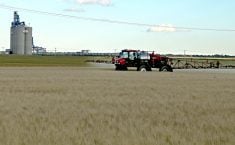Canadian Federation of Agriculture president Bob Friesen rarely passes up a chance to remind audiences that the tip that diners leave for restaurant servers is more than the farmers who grew the food receive.
Statistics Canada now is reporting that there are more of those servers and bartenders making money from farmers than ever before, while the number of farmers producing the products they serve continues to fall.
By defining the food service industry as part of the agri-food sector, the federal agency was able to report in December that employment in the sector remains at levels it attained 20 years ago – 15 percent of employment, one of the largest job sectors in the economy.
Read Also

New coal mine proposal met with old concerns
A smaller version of the previously rejected Grassy Mountain coal mine project in Crowsnest Pass is back on the table, and the Livingstone Landowners Group continues to voice concerns about the environmental risks.
And it is growing.
“From 1981 to 1996, employment in the broad agriculture and agri-food sector grew by 24 percent,” said a Statistics Canada analysis. “The growth was greater than overall employment growth in Canada over this period.”
But those overall statistics mask several less-encouraging trends. Food sector jobs were holding their own because of the growth of low income service jobs while the number of Canadians employed producing the food or processing it was falling.
Direct jobs in primary agriculture and food production declined by more than 35,000 in the years 1991-96 to 485,605, while jobs in the agri-food sector increased by 60,000 to more than 1.6 million.
The difference was the expansion of employment in bars and restaurants. Between 1981 and 1996, employment in that sector grew 74 percent or by 336,000 jobs.
“In 1981, more people worked on farms than in restaurants and drinking establishments,” said the Statistics Canada analysis.
“By 1996, the latter group far surpassed the former…. Employment in the food and beverage service sector was 63 percent larger than farm employment.”
The news was not as optimistic in the food processing sector, typically higher paying jobs.
“Food processing is often promoted as part of agricultural policy to provide a local market for Canadian farmers and as part of rural development policy to create jobs in rural areas,” said the analysis.
“However, in 1996 fewer people were working in Canada’s food processing sector than in 1981. More food was processed but fewer workers were involved.”
Prince Edward Island, Quebec and New Brunswick hosted the largest percentage of food processing jobs in Canada.
The federal agency said during the 15 years to 1996, agri-food jobs increased more in rural areas than in urban areas, although it was largely in the food service area.
“Among the major agri-food sectors, predominantly rural regions are gaining relative intensity in employment in restaurants, taverns and bars but their intensity is not yet at the Canadian average,” said the Statistics Canada analysis.
Rural regions remain proportionately more likely than urban areas to have jobs in food retailing and wholesale and in food processing.
Still, the fastest growth was in the serving industry.
















